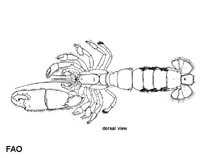Neotrypaea japonica (Ortmann, 1891)
Japanese ghost shrimp
Classification / Names Common names | Synonyms | CoL | ITIS | WoRMS
Malacostraca | Decapoda | Callianassidae
Environment: milieu / climate zone / depth range / distribution range Ecology
Benthic; brackish. Subtropical; 44°N - 31°N, 116°E - 143°E (Ref. 4)
Distribution Countries | FAO areas | Ecosystems | Occurrences | Introductions
Western Pacific.
Length at first maturity / Size / Weight / Age
Maturity: Lm ? range ? - ? cmCommon length : 7.0 cm TL male/unsexed; (Ref. 4)
Short description Morphology
Rostrum a low blunt angle of anterior margin of carapace. Eyes triangular, overreaching rostrum with their full length. Antennal spine absent, antennal angle conspicuous and blunt. Peduncles of antennula and of antenna of about same length. Third maxilliped with merus and ischium considerably widened, forming operculum; the last three segments narrow, about twice as long as wide. Laeg chelate of adult male with a distinct concavity in the anterior margin above the base of the fixed finger; in females and young males this concavity is absent or insignificant. Carpus about as long as palm and about as long as high. Merus of adult males with a distinct rounded, forwards produced lobe in basal half of lower margin, upper margin of merus serrate; in females and young males the lobe is much smaller, more triangular, upper margin of merus smooth or indistinctly serrate. Telson longer than wide at base, quadrangular in outline; narrowing slightly posteriorly; posterolateral angles rounded. A small denticle in the middle of the posterior margin, otherwise telson unarmed. Endopod or uropod broadly quadrangular with rounded corners, slightly longer than telson (Ref. 4).
It has body lengths of 1.2 to 6 cm, rarely 7 cm, total body length; 2.5 to at least 5 cm, ovigerous females (Ref. 4). It is found on intertidal mud flats in protected habitats; it makes burrows on soft substrate (Ref. 4).
Life cycle and mating behavior Maturity | Reproduction | Spawning | Eggs | Fecundity | Larvae
Members of the order Decapoda are mostly gonochoric. Mating behavior: Precopulatory courtship ritual is common (through olfactory and tactile cues); usually indirect sperm transfer.
Main reference
References | Coordinator | Collaborators
Holthuis, L.B. 1991. (Ref. 4)
IUCN Red List Status (Ref. 130435)
CITES status (Ref. 108899)
Not Evaluated
CMS (Ref. 116361)
Not Evaluated
Threat to humans
Human uses
Bait: usually
| FishSource |
Tools
More information
Internet sources
BHL | BOLD Systems | CISTI | DiscoverLife | FAO(Publication : search) | Fishipedia | GenBank (genome, nucleotide) | GloBI | Gomexsi | Google Books | Google Scholar | Google | PubMed | Tree of Life | Wikipedia (Go, Search) | Zoological Record
Estimates based on models
Preferred temperature
(Ref. 115969): 16.9 - 21.9, mean 20 (based on 123 cells).



